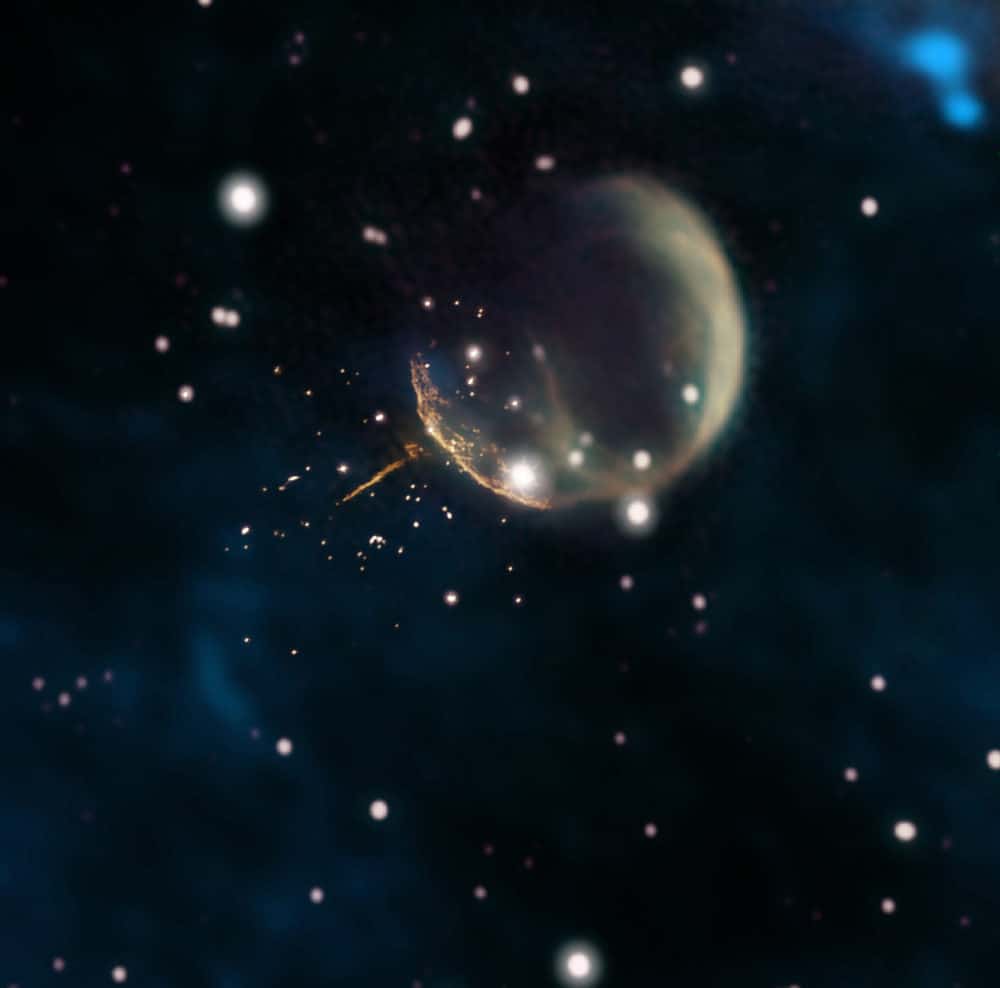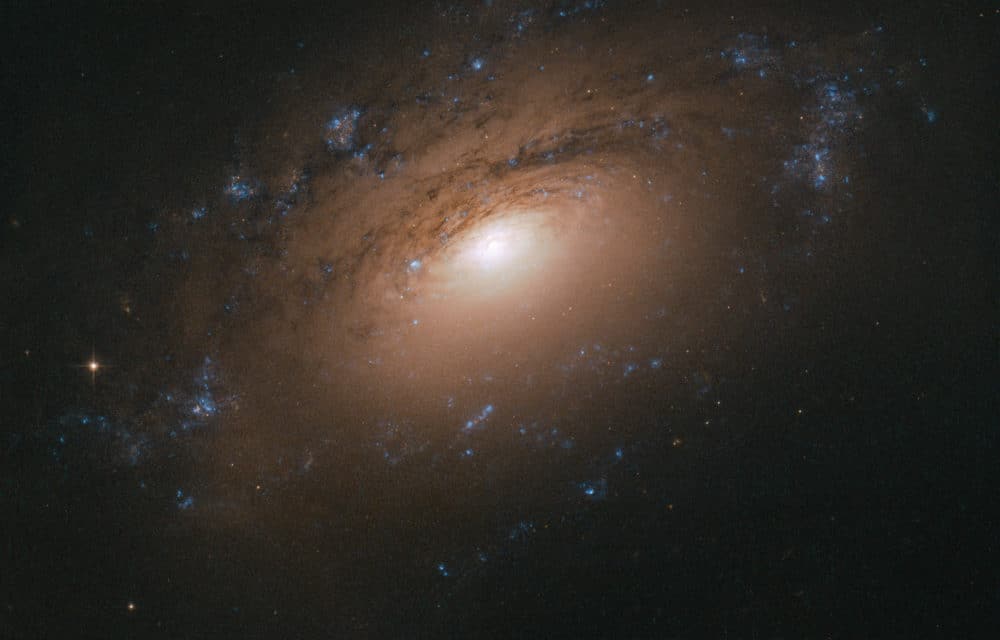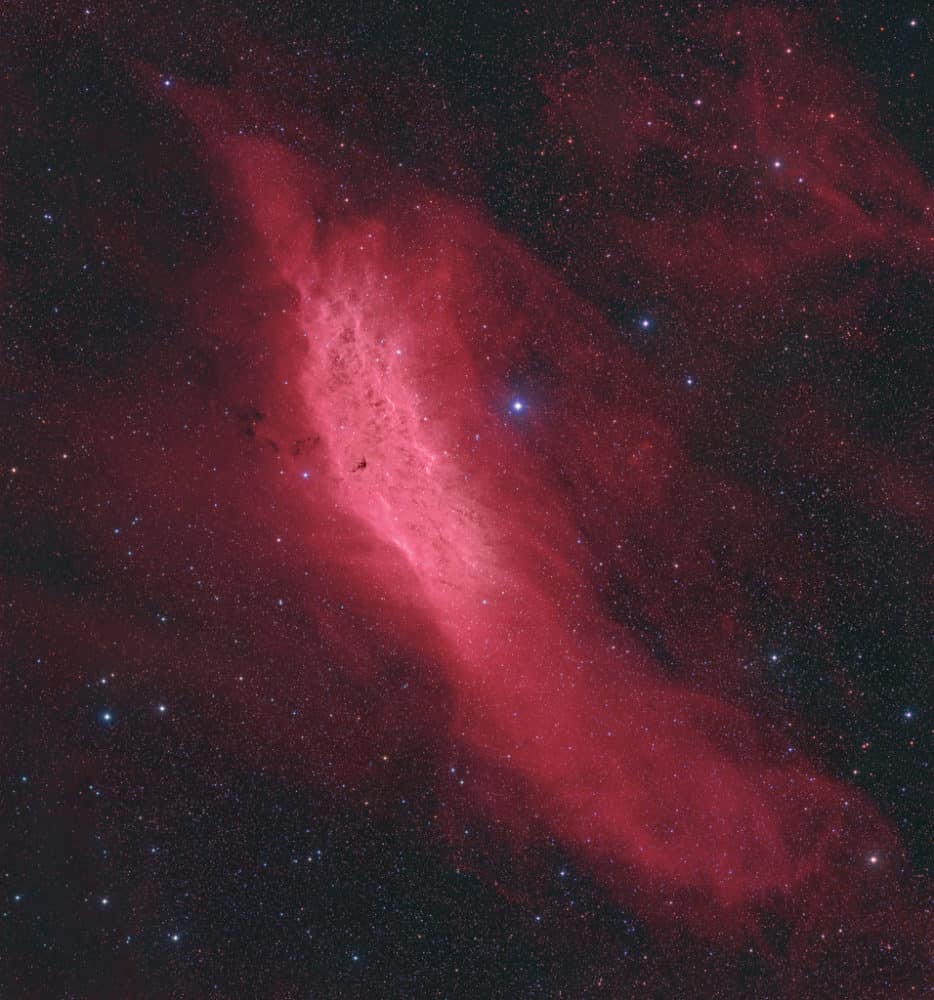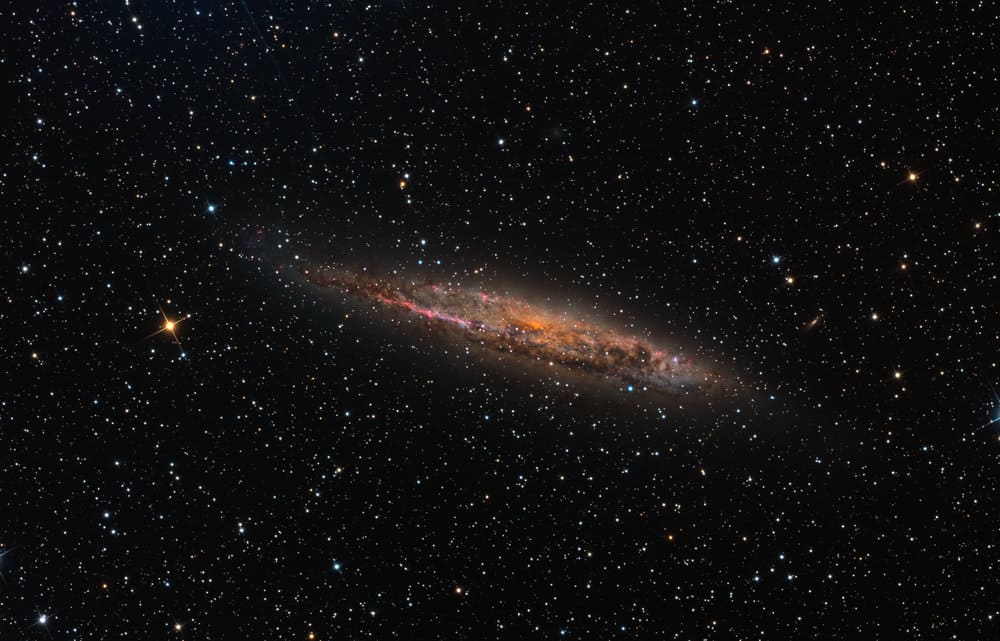Blog
Pulsars are superdense, rapidly spinning neutron stars left behind when a massive star explodes. Their rotational periods ranging from more than 10 seconds to just a few milliseconds. Since their discovery in 1967, various surveys have discovered over 2,600 pulsars. PSR J0002+6216 was discovered in 2017 by a citizen-science project called Einstein@Home. Located about 6,500 light-years away in the constellation Cassiopeia, this pulsar spins 8.7 times a second, producing a pulse of gamma rays with each rotation. “This pulsar has completely escaped the remnant of debris from the supernova explosion. It’s very rare for a pulsar to get enough of a kick for us to see this,” said Dr. Frank Schinzel, an astronomer at the National Radio Astronomy Observatory (NRAO). Radio observations with the Very Large Array clearly show PSR J0002+6216 outside the supernova remnant, with a tail of shocked particles and magnetic energy 13 light-years long behind it. The tail points back toward the center of the CTB 1 supernova remnant. “Measuring the pulsar’s motion and tracing it backwards shows that it was born at the center of the remnant, where the supernova explosion occurred. The pulsar now is 53 light-years from the center of CTB 1,” said Dr. Matthew Kerr, of the Naval Research Laboratory. “The explosion debris in the supernova remnant originally expanded faster than the pulsar’s motion,” said Dr. Dale Frail, of NRAO. “However, the debris was slowed by its encounter with the tenuous material in interstellar space, so the pulsar was able to catch up and overtake it.”
more...Pat Martino (born August 25, 1944) is a jazz guitarist and composer. Martino was born Pat Azzara in South Philadelphia. He began playing professionally at the age of 15 after moving to New York City. He lived for a period with Les Paul and began playing at jazz clubs such as Smalls Paradise. He later moved into a suite in the President Hotel on 48th Street. He would play at Smalls for six months of the year, and then in the summer play at the Club Harlem in Atlantic City.
Martino played and recorded early in his career with Lloyd Price, Willis Jackson, and Eric Kloss. He also worked with jazz organists Charles Earland, Richard “Groove” Holmes, Jack McDuff, Don Patterson, Trudy Pitts, Jimmy Smith, Gene Ludwig, and Joey DeFrancesco.
Martino had been performing until an aneurysm in 1980 left him with amnesia and no recollection or knowledge of his career or how to play the very instrument that made him successful. Martino says he came out of surgery with complete forgetfulness, learning to focus on the present instead of the past or what may lie ahead. He was forced to learn how to play the guitar from zero. This circumstance is crucial to understand his career and his particular way of thinking.
Martino is married to Ayako Asahi Martino, whom he met in Tokyo, Japan, in 1995.
He was chosen as Guitar Player of the Year in the Down Beat magazine Readers’ Poll of 2004. In 2006, Mobile Fidelity Sound Lab reissued his album East! on Ultradisc UHR SACD.
In 2017, he shot a series of educational videos entitled A Study of the Opposites and How They Manifest on the Guitar.
more...Wayne Shorter (born August 25, 1933) is an American jazz saxophonist and composer.
Shorter came to wide prominence in the late 1950s as a member of, and eventually primary composer for Art Blakey‘s Jazz Messengers. In the 1960s, he went on to join Miles Davis‘s Second Great Quintet, and from there he co-founded the jazz fusion band Weather Report. He has recorded over 20 albums as a bandleader.
Many of Shorter’s compositions have become jazz standards, and his output has earned worldwide recognition, critical praise and various commendations. Shorter has won 11 Grammy Awards. He has also received acclaim for his mastery of the soprano saxophone (after switching his focus from the tenor in the late 1960s), beginning an extended reign in 1970 as Down Beat‘s annual poll-winner on that instrument, winning the critics’ poll for 10 consecutive years and the readers’ for 18. The New York Times described Shorter in 2008 as “probably jazz’s greatest living small-group composer and a contender for greatest living improviser.” In 2017, he was awarded the Polar Music Prize.Wayne Shorter was born in Newark, New Jersey, and attended Newark Arts High School, from which he graduated in 1952. He loved music, being encouraged by his father to take up the clarinet as a teenager; his older brother Alan played alto saxophone before switching to the trumpet in college. While in high school Wayne also performed with the Nat Phipps Band in Newark, NJ. After graduating from New York University with a degree in music education in 1956, Shorter spent two years in the U.S. Army, during which time he played briefly with Horace Silver. After his discharge, he played with Maynard Ferguson. In his youth Shorter had acquired the nickname “Mr. Gone”, which later became an album title for Weather Report.
Leonard Bernstein (/ˈbɜːrnstaɪn/ BURN-styne; August 25, 1918 – October 14, 1990) was an American composer, conductor, author, music lecturer, and pianist. He was among the first conductors born and educated in the US to receive worldwide acclaim. According to music critic Donal Henahan, he was “one of the most prodigiously talented and successful musicians in American history.”
His fame derived from his long tenure as the music director of the New York Philharmonic, from his conducting of concerts with most of the world’s leading orchestras, and from his music for West Side Story, Peter Pan, Candide, Wonderful Town, On the Town, On the Waterfront, his Mass, and a range of other compositions, including three symphonies and many shorter chamber and solo works.
Bernstein was the first conductor to give a series of television lectures on classical music, starting in 1954 and continuing until his death. He was a skilled pianist, often conducting piano concertos from the keyboard. He was also a critical figure in the modern revival of the music of Gustav Mahler, the composer he was most passionately interested in.
As a composer he wrote in many styles encompassing symphonic and orchestral music, ballet, film and theatre music, choral works, opera, chamber music and pieces for the piano. Many of his works are regularly performed around the world, although none has matched the tremendous popular and critical success of West Side Story. He was born Louis Bernstein in Lawrence, Massachusetts, the son of Ukrainian Jewish parents Jennie (née Resnick) and Samuel Joseph Bernstein, a hairdressing supplies wholesaler originating from Rovno (now Ukraine).
NGC 3169 is located approximately 76 million light-years away in the constellation of Sextans.Also known as LEDA 29855 or UGC 5525, the spiral galaxy was discovered by the German-born British astronomer William Herschel in 1783.NGC 3169 is a member of the Leo I Group of galaxies, which is part of a larger galactic congregation known as the Virgo Supercluster.The galaxy is located relatively close to another spiral galaxy, NGC 3166.The distance between them is just 50,000 light-years, a separation that is only about half the diameter of our Milky Way Galaxy.The two comprise a physical pair and influence each other gravitationally. NGC 3169’s arms, shining bright with big, young, blue stars, have been teased apart, and lots of luminous gas has been drawn out from its disk. The galaxy’s bright center is encircled by thick dust lanes. “Cosmic dust comprises a potpourri of particles, including water ice, hydrocarbons, silicates, and other solid material,” Hubble astronomers said. “It has many origins and sources, from the leftovers of star and planet formation to molecules modified over millions of years by interactions with starlight.”
more...Oteil Burbridge is an American multi-instrumentalist, specializing on the bass guitar, trained in playing jazz and classical music from an early age. He has achieved fame primarily on bass guitar during the resurgence of the Allman Brothers Band from 1997 through 2014, and as a founding member of the band Dead & Company. Burbridge was also a founding member of The Aquarium Rescue Unit, and has worked with other musicians including Bruce Hampton, Trey Anastasio, Page McConnell, Bill Kreutzmann and The Derek Trucks Band, with whom his brother Kofi Burbridge was the keyboardist and flautist.
Burbridge has been recognized for his ability to incorporate scat-singing into his improvised bass solos. Burbridge endorses Fodera, Modulus, Sukop and Dunlop guitars and effects. Burbridge was born and raised in Washington, D.C., to an African American family with some Egyptian heritage. His name, Oteil, means “explorer” or “wanderer”. When he and elder sibling Kofi showed talent for music, their mother encouraged them with classical and jazz courses hoping to nurture their musical inclinations and keep them out of trouble. Kofi remembers Oteil’s first drum set: a Quaker Oatmeal box, when he was only three or four years old. Both brothers were introduced to a wide variety of instruments, and became multi-instrumentalists, with both being taught to play the piano. Oteil gained proficiency on the bass clarinet, violin,and trumpet; however, bass guitar and drums became his instruments of choice (while Kofi developed a love for both flute and keyboards).
John Cipollina (August 24, 1943 – May 29, 1989) was a guitarist best known for his role as a founder and the lead guitarist of the prominent San Francisco rock band Quicksilver Messenger Service. After leaving Quicksilver he formed the band Copperhead, was a member of the San Francisco All Stars and later played with numerous other bands, including Janis Joplin on the Dick Cavett show. Born in Berkeley, California in 1943, Cipollina attended Tamalpais High School, in Mill Valley, California (as did his brother, Mario, born 1954) and sister, Antonia (born 1952). Their father, Gino, was a realtor, and their mother, Evelyn, and godfather José Iturbi, were concert pianists.
John showed great promise as a classical pianist in his youth, but his father gave him a guitar when he was 12 and this quickly became his primary instrument. Cipollina had a unique guitar sound, mixing solid state and valve amplifiers as early as 1965. He is considered one of the fathers of the San Francisco psychedelic rock sound. To create his distinctive guitar sound, Cipollina developed a one-of-a-kind amplifier stack. His Gibson SG guitars had two pickups, one for bass and one for treble. The bass pickup fed into two Standel bass amps on the bottom of the stack, each equipped with two 15-inch speakers. The treble pickups fed two Fender amps: a Fender Twin Reverb and a Fender Dual Showman that drove six Wurlitzer horns.
more...Arthur William “Big Boy” Crudup (August 24, 1905 – March 28, 1974) was an American Delta blues singer, songwriter and guitarist. He is best known, outside blues circles, for his songs “That’s All Right” (1946), “My Baby Left Me” and “So Glad You’re Mine”, later recorded by Elvis Presleyand other artists.
Crudup was born in Forest, Mississippi, to a family of migrant workers traveling through the South and Midwest. The family returned to Mississippi in 1926, where he sang gospel music. He had lessons with a local bluesman, whose name was Papa Harvey, and later he was able to play in dance halls and cafes around Forest. Around 1940 he went to Chicago. He began his career as a blues singer around Clarksdale, Mississippi. As a member of the Harmonizing Four, he visited Chicago in 1939. He stayed in Chicago to work as a solo musician but barely made a living as a street singer. The record producer Lester Melrose allegedly found him while Crudup was living in a packing crate, introduced him to Tampa Red and signed him to a recording contract with RCA Victor‘s Bluebird label. He recorded with RCA in the late 1940s and with Ace Records, Checker Records and Trumpet Records in the early 1950s. He toured black clubs in the South, sometimes playing with Sonny Boy Williamson II and Elmore James.[4] He also recorded under the names Elmer James and Percy Lee Crudup. His songs “Mean Old ‘Frisco Blues”, “Who’s Been Foolin’ You” and “That’s All Right” were popular in the South.[5] These and his other songs “Rock Me Mama”, “So Glad You’re Mine”, and “My Baby Left Me” have been recorded by many artists, including Elvis Presley, Slade, Elton John and Rod Stewart.
more...Tanzania
more...https://www.youtube.com/watch?v=dgCUzw4_65c
more...Drifting through the Orion Arm of the spiral Milky Way Galaxy, this cosmic cloud by chance echoes the outline of California on the west coast of the United States. Our own Sun also lies within the Milky Way’s Orion Arm, only about 1,500 light-years from the California Nebula. Also known as NGC 1499, the classic emission nebula is around 100 light-years long. The California Nebula shines with the telltale reddish glow characteristic of hydrogen atoms recombining with long lost electrons. The electrons have been stripped away, ionized by energetic starlight. Most likely providing the energetic starlight that ionizes much of the nebular gas is the bright, hot, bluish star Xi Persei just to the right of the nebula. A popular target for astrophotographers, this deep California Nebula image is a 6 panel telecopic mosaic and covers a wide field of view. The nebula lies toward the constellation Perseus, not far from the Pleiades.
more...Robert Michael Watson Jr. (born August 23, 1953), known professionally as Bobby Watson, is an American saxophonist, composer, and educator.
Watson was born in Lawrence, Kansas and grew up in Kansas City, Kansas. He attended the University of Miami at the same time as Pat Metheny, Jaco Pastorius, and Bruce Hornsby. He graduated in 1975, moved to New York City, and became music director for the Jazz Messengers from 1977 to 1981. After leaving the band, he was productive as a session musician, recording with Wynton Marsalis, Branford Marsalis, Max Roach, Joe Williams, Dianne Reeves, Lou Rawls, Betty Carter, and Carmen Lundy. He formed the band Bobby Watson & Horizon with bassist Curtis Lundy and drummer Victor Lewis, with whom he played throughout the 1980s and ’90s.
Watson led a group known as the High Court of Swing (a tribute to the music of Johnny Hodges), the sixteen-piece Tailor-Made Big Band, and is a founding member of the 29th Street Saxophone Quartet, an all-horn, four-piece group with alto saxophonist Ed Jackson, tenor saxophonist Rich Rothenberg, and baritone saxophonist Jim Hartog. Watson also composed a song for the soundtrack to the movie A Bronx Tale (1993).
A resident of New York for most of his professional life, he served as a member of the adjunct faculty and taught saxophone privately at William Paterson University from 1985 to 1986 and the Manhattan School of Music from 1996 to 1999. He is involved with the Thelonious Monk Institute‘s annual Jazz in America high school outreach program.
more...Terje Rypdal (born 23 August 1947) is a Norwegian guitarist and composer. He has been an important member in the Norwegian jazz community, and has also given show concerts with guitarists Ronni Le Tekrø and Mads Eriksen as “N3”.Rypdal was born in Oslo, the son of a composer and orchestra leader. He studied classical piano and trumpet as a child, and then taught himself to play guitar as he entered his teens. Starting out as a Hank Marvin-influenced rock guitarist with The Vanguards, Rypdal turned towards jazz in 1968 and joined Jan Garbarek‘s group and later George Russell‘s sextet and orchestra. An important step towards international attention was his participation in the free jazz festival in Baden-Baden, Germany, in 1969, where he was part of a band led by Lester Bowie. During his musical studies at Oslo university and conservatory, he led the orchestra of the Norwegian version of the musical Hair. He has often been recorded on the ECM record label, both jazz-oriented material and classical compositions (some of which do not feature Rypdal’s guitar).
Keith John Moon (23 August 1946 – 7 September 1978) was an English drummer for the rock band the Who. He was noted for his unique style and his eccentric, often self-destructive behaviour. His drumming continues to be praised by critics and musicians. He was posthumously inducted into the Modern Drummer Hall of Fame in 1982, becoming only the second rock drummer to be chosen, and in 2011, Moon was voted the second-greatest drummer in history by a Rolling Stone readers’ poll.
Moon grew up in Alperton, a suburb of Wembley, in Middlesex, and took up the drums during the early 1960s. After playing with a local band, the Beachcombers, he joined the Who in 1964 before they recorded their first single. Moon remained with the band during their rise to fame, and was quickly recognised for his drumming style, which emphasised tom-toms, cymbal crashes, and drum fills. Throughout Moon’s tenure with the Who his drum kit steadily grew in size, and along with Ginger Baker, Moon has been credited as one of the earliest rock drummers to regularly employ double bass drums in his setup. He occasionally collaborated with other musicians and later appeared in films, but considered playing in the Who his primary occupation and remained a member of the band until his death. In addition to his talent as a drummer, however, Moon developed a reputation for smashing his kit on stage and destroying hotel rooms on tour. He was fascinated by blowing up toilets with cherry bombs or dynamite, and by destroying television sets. Moon enjoyed touring and socialising, and became bored and restless when the Who were inactive. His 21st birthday party in Flint, Michigan, has been cited as a notorious example of decadent behaviour by rock groups.
Moon suffered a number of setbacks during the 1970s, most notably the accidental death of chauffeur Neil Boland and the breakdown of his marriage. He became addicted to alcohol, particularly brandy and champagne, and acquired a reputation for decadence and dark humour; his nickname was “Moon the Loon”. After moving to Los Angeles with personal assistant Peter “Dougal” Butler during the mid-1970s, Moon recorded his only solo album, the poorly received Two Sides of the Moon. While touring with the Who, on several occasions he passed out on stage and was hospitalised. By their final tour with him in 1976, and particularly during production of The Kids Are Alright and Who Are You, the drummer’s deterioration was evident. Moon moved back to London in 1978, dying in September of that year from an overdose of Heminevrin, a drug intended to treat or prevent symptoms of alcohol withdrawal.
https://www.youtube.com/watch?v=vCupJpymgfE
more...Alvin Gilbert “Gil” Coggins (August 23, 1928 – February 15, 2004) was an American jazz pianist.
Coggins was born to parents of West Indian heritage. His mother was a pianist and had her son start on piano from an early age. He attended school in New York City and Barbados. In Harlem, New York City, he attended The High School of Music & Art.
In 1946, Coggins met Miles Davis while stationed at Jefferson Barracks in Missouri. After his discharge he began playing piano professionally, working with Davis on several of his Blue Note and Prestige releases. Coggins also recorded with John Coltrane, Sonny Rollins, Lester Young, Art Blakey‘s Jazz Messengers, Ray Draper, and Jackie McLean.
Coggins gave up playing jazz professionally in 1954 and took up a career in real estate, playing music only occasionally. He did not record as a leader until 1990, when Interplay Records released Gil’s Mood. He continued performing through the 1990s and 2000s until 2004, when he died from complications sustained in a car crash eight months earlier in Forest Hills, New York. Better Late Than Never, his second album recorded as a leader, was released posthumously.
more...Flamenco Fridays featuring Solearas. Soleares (plural of soleá, pronounced [soleˈa]) is one of the most basic forms or palos of Flamenco music, probably originated around Cádiz or Seville in Andalusia, the most southern region of Spain. It is usually accompanied by one guitar only, in phrygian mode “por arriba” (fundamental on the 6th string); “Bulerías por soleá” is usually played “por medio” (fundamental on the 5th string). Soleares is sometimes called “mother of palos” although it is not the oldest one (e.g. siguiriyas is older than soleares) and not even related to every other palo (e.g. fandangos family is from a different origin).
Soléa develops in (altered) Phrygian mode “por arriba” (fundamental on the 6th string), with the III degree of the mode altered to a major 3rd when resolving to I.
To adapt to the singer’s vocal range, guitarists can use a “cejilla” (capo) to play in any key while preserving the known chord positions. Modern guitarists often play soleá using other chord positions or even changing the tuning of the guitar to experiment with new sounds, especially in solo instrumental pieces.
The typical flamenco progression iv, III, II, I (an altered Phrygian cadence) is heard several times during the development of the song. In E altered Phrygian, the progression would be Am, G, F, E (the E chord should be Em in a diatonic Phrygian cadence, but its diatonic third – G – is altered to a G♯).
more...
https://www.youtube.com/watch?v=nMkShK-cqsw
more...Large spiral galaxy NGC 4945 is seen edge-on near the center of this cosmic galaxy portrait. In fact, it’s almost the size of ourMilky Way Galaxy. NGC 4945’s own dusty disk, young blue star clusters, and pink star forming regions standout in the sharp, colorful telescopic image. About 13 million light-years distant toward the expansive southern constellation Centaurus, NGC 4945 is only about six times farther away than Andromeda, the nearest large spiral galaxy to the Milky Way. Though this galaxy’s central region is largely hidden from view for optical telescopes, X-ray and infrared observations indicate significant high energy emission and star formation in the core of NGC 4945. Its obscured but active nucleus qualifies the gorgeous island universe as a Seyfert galaxy and home to a central supermassive black hole.
more...More Posts
- The Cosmos with Meteor M31
- Pat Metheny Day
- Papa Joe Jones Day
- World Music with Elle Márjá Eira
- Daily Roots with Stranger Cole
- The Cosmos with NGC 6357
- Vikku Vinayakram Day
- Bruz Freeman Day
- World Music with the Bushmen & Himba
- Daily Roots with the Dynamics
- World Music with Francisco Tarrega
- The Cosmos with IC 4406
- FRIDOLijN Day
- Chuck Israels Day
- Trudy Pitts Day
- World Music with Rahul Sharma
- Daily Roots with Jackie Mitto & The Soul Vendors
- The Cosmos with LL Ori
- Andile Yenana Day
- Jack DeJohnette Day



